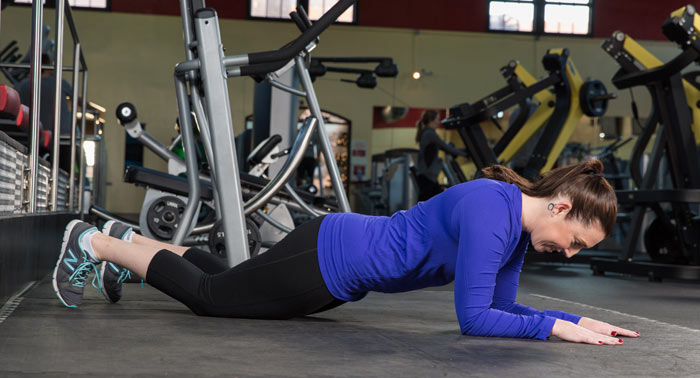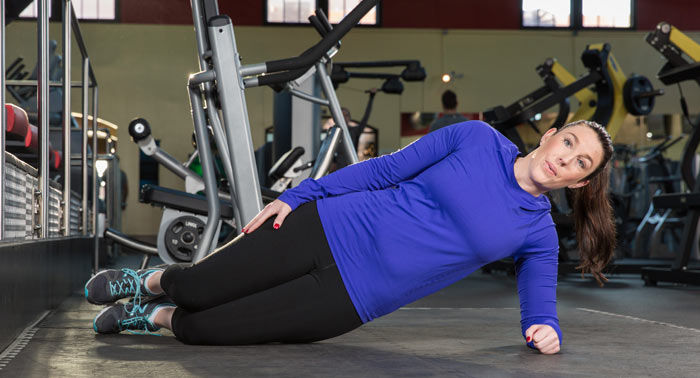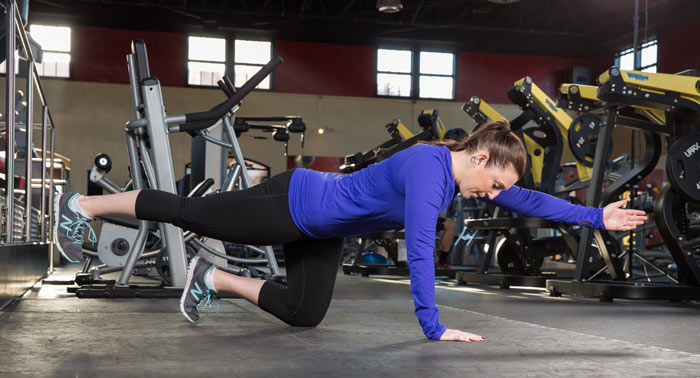Are you just getting started with a fitness routine and aren’t sure how to train your core? Here are a few basic core movements for beginners, with advanced options that can be done once you’ve mastered the basic exercises.
Modified Plank

Lie on your stomach on an exercise mat or floor with your elbows close to your sides and directly under your shoulders, palms down and fingers facing forward. Engage your abdominal/core muscles. It should feel like you are tightening a corset around your ribs, waist and lower torso.
Once your core is engaged, slowly lift your torso and the upper part of your thighs off of the mat, while the knees remain on the floor. Do not allow the lower back to sag or the hips to lift up in the air. Your shoulders should remain away from the ears. If wrist pain is an issue, drop to your elbows. Try holding this position a couple of times while continuing to breathe and maintain good form.
Try this position before moving into a full plank so you understand the concept of how to engage your core. This will also give you a sense of how strong your arms are as you hold yourself up in a plank position.
Advanced: Begin in full plank position and place a small weightless ball under your rib cage. This will keep your body position accountable while you attempt to lift the opposite leg and arm simultaneously; repeat on the other side.
Modified Side Plank

Lie on your side with your knees bent and stacked on each other; do your best to keep a straight line from the top of your head to your knees. Engage your core muscles (as discussed in the plank exercise) and slowly lift your torso, supporting yourself with your forearm directly under your shoulder.
Try this position before moving into a full side plank so you understand the concept of how to engage your core. This will also give you a sense of how strong your arms are as you hold yourself up in a plank position.
Advanced: Do a forearm plank with your legs on top of a stability ball. One leg at a time, drive your knee into the stability ball to make the surface unstable.
Reverse Crunch

Lie on you back with your knees bent to 90 degrees and your core muscles engaged. Place your arms out to the side with palms facing down. Keep your knees directly above the hips at 90 degrees and slowly drop your legs toward the floor. Once you feel loss of core control and/or your back start to arch, bring the legs back to the starting position and repeat the exercise. Do not move your upper body or your head during this exercise. Depending on your level of core strength, this movement could be very small. The stronger your core becomes, the lower you will be able to drop your legs.
Advanced: Lie on your back with your legs at 90 degrees and place a small weightless ball on your shins. Do not hold the ball with your legs or let it sink down toward your ankles. Lift your torso up off the ground and twist to the right and the left.
Bird Dog

Place a mat on the floor and come on to all fours with your hands and knees on the ground. Your hands should be directly under your shoulders (fingers facing forward) and your knees should be underneath your hips. Keep a straight line from the top of the head to the hips and engage your core as you extend the opposite arm and leg simultaneously. Place your hand and knee back on the ground and repeat the extension movement on the same side. To protect the lower back, don’t allow the arms and legs to extend up past hip height. Always keep your core engaged and your spine in a neutral position. Once you have completed one side, move to the other side, keeping your movements as controlled and fluid as possible.
Advanced: Continue with the same movement, but abduct the arm and leg (moving it away from the midline of the body) while trying to remain balanced.




 by
by 






 by
by